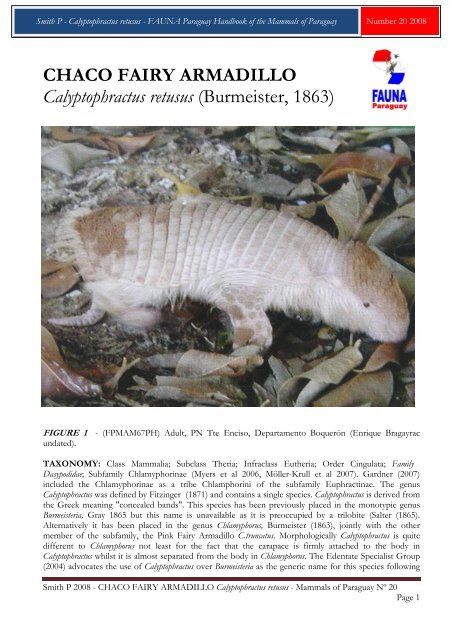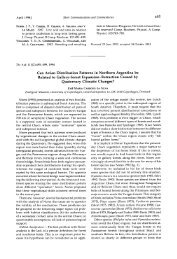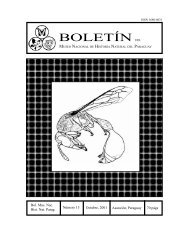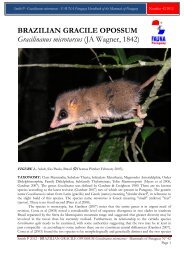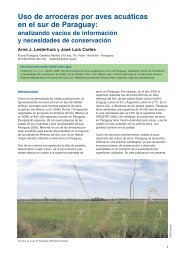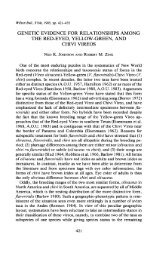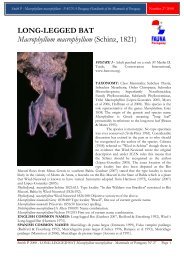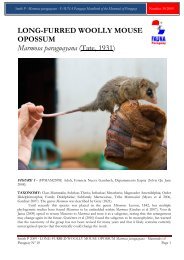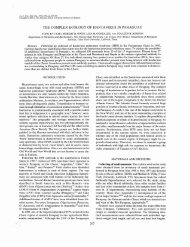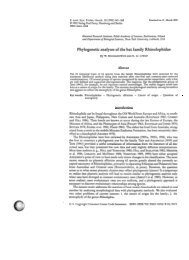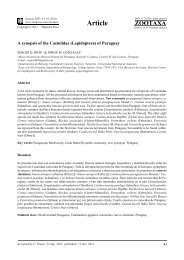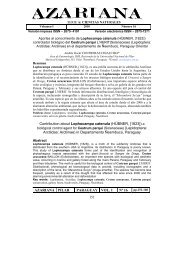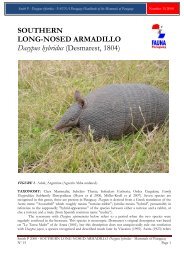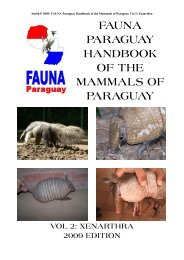CHACO FAIRY ARMADILLO Calyptophractus ... - FAUNA Paraguay
CHACO FAIRY ARMADILLO Calyptophractus ... - FAUNA Paraguay
CHACO FAIRY ARMADILLO Calyptophractus ... - FAUNA Paraguay
Create successful ePaper yourself
Turn your PDF publications into a flip-book with our unique Google optimized e-Paper software.
Smith P - <strong>Calyptophractus</strong> retusus - <strong>FAUNA</strong> <strong>Paraguay</strong> Handbook of the Mammals of <strong>Paraguay</strong> Number 20 2008<br />
<strong>CHACO</strong> <strong>FAIRY</strong> <strong>ARMADILLO</strong><br />
<strong>Calyptophractus</strong> retusus (Burmeister, 1863)<br />
FIGURE 1 - (FPMAM67PH) Adult, PN Tte Enciso, Departamento Boquerón (Enrique Bragayrac<br />
undated).<br />
TAXONOMY: Class Mammalia; Subclass Theria; Infraclass Eutheria; Order Cingulata; Family<br />
Dasypodidae; Subfamily Chlamyphorinae (Myers et al 2006, Möller-Krull et al 2007). Gardner (2007)<br />
included the Chlamyphorinae as a tribe Chlamphorini of the subfamily Euphractinae. The genus<br />
<strong>Calyptophractus</strong> was defined by Fitzinger (1871) and contains a single species. <strong>Calyptophractus</strong> is derived from<br />
the Greek meaning "concealed bands". This species has been previously placed in the monotypic genus<br />
Burmeisteria, Gray 1865 but this name is unavailable as it is preoccupied by a trilobite (Salter (1865).<br />
Alternatively it has been placed in the genus Chlamyphorus, Burmeister (1863), jointly with the other<br />
member of the subfamily, the Pink Fairy Armadillo C.truncatus. Morphologically <strong>Calyptophractus</strong> is quite<br />
different to Chlamyphorus not least for the fact that the carapace is firmly attached to the body in<br />
<strong>Calyptophractus</strong> whilst it is almost separated from the body in Chlamyphorus. The Edentate Specialist Group<br />
(2004) advocates the use of <strong>Calyptophractus</strong> over Burmeisteria as the generic name for this species following<br />
Smith P 2008 - <strong>CHACO</strong> <strong>FAIRY</strong> <strong>ARMADILLO</strong> <strong>Calyptophractus</strong> retusus - Mammals of <strong>Paraguay</strong> Nº 20<br />
Page 1
Smith P - <strong>Calyptophractus</strong> retusus - <strong>FAUNA</strong> <strong>Paraguay</strong> Handbook of the Mammals of <strong>Paraguay</strong> Number 20 2008<br />
Wetzel (1985) and this was also followed by Gardner (2007). The species is monotypic. Synonyms adapted<br />
from Gardner (2007):<br />
Chlamyphorus retusus Burmeister 1863:167. Type locality "Santa Cruz de la Sierra" Santa Cruz, Bolivia.<br />
Burmeisteria retusa Gray 1865:381. Name combination.<br />
<strong>Calyptophractus</strong> retusus Fitzinger 1871:389. First use of current name.<br />
Burmeisteria retusa clorindae Yepes 1939:38. Type locality "Tapia en la gobernaciòn de Formosa" Argentina.<br />
ENGLISH COMMON NAMES: Chaco Fairy Armadillo (Redford & Eisenberg 1992), Greater Fairy<br />
Armadillo (Redford & Eisenberg 1992), Burmeister´s Fairy Armadillo (Cimardi 1996), Burmeister´s<br />
Armadillo (IUCN 2008), Greater Pichi Ciego (IUCN 2008), Northern Pich-ciego (Anderson 1997).<br />
SPANISH COMMON NAMES: Pichiciego grande (Redford & Eisenberg 1992, Cuéllar & Noss 2003),<br />
Pichiciego mayor (Abba & Superina 2010), Coseveru (Anderson 1997), Culo tapado (Cuéllar & Noss<br />
2003), Tatú ciego, Tatú de abrigo. The Spanish name "Culo tapado" means in vulgar terms "Butt plug", a<br />
reference to the flattened, hardened rump region which is used to block tunnels as a defence mechanism.<br />
GUARANÍ COMMON NAMES: Tatu jeikuarajoya (Cuéllar & Noss 2003). Roughly translated the<br />
Guaraní name means "short-anus armadillo".<br />
DESCRIPTION: Bizarre, subterranean mole-like armadillo with greatly reduced eye and ear. The<br />
carapace is pinkish with an undulating lateral edge, and attached firmly to the skin of the dorsum. It has<br />
approximately 23 rows of squarish scutes. The rump is armoured with an ovoid "plug" that naked, pinkish<br />
and scattered with roundish scales. Tail short, pinkish, lightly armoured and lacking a spatulate tip, located<br />
at the lower edge of the anal carapace. The head shield widens posteriorly and has a rounded posterior<br />
edge, it does not extend below the level of the eye. Heavily-furred both ventrally and laterally, the pelage<br />
being whitish with a golden tinge towards the midline. The sides of the head are also furred. Forelimbs are<br />
pinkish, largely naked with large, irregular vestiges of scutes. Forefeet armed with three greatly enlarged<br />
claws (digits 1-3), and one smaller claw, adapted for digging. The three larger claws are rotated so that they<br />
are visible laterally. Hindfoot with five toes, similarly arranged but with reduced claws when compared to<br />
the forefeet.<br />
CRANIAL CHARACTERISTICS: No information.<br />
DENTAL CHARACTERISTICS: No information.<br />
GENETIC CHARACTERISTICS: 2n=64.<br />
TRACKS AND SIGNS: No information.<br />
EXTERNAL MEASUREMENTS: Much the smallest of the <strong>Paraguay</strong>an armadillos. Measurements for<br />
Bolivian individuals, two males and two females HB: male 13.5-14.5cm, female 12.5-13.2cm; TA: male<br />
3.5-3.6cm, female 3.3-3.5cm; FT: male 3cm, female 2.8-3cm; EA: male 0.5-0.6cm, female 0.5cm; WT:<br />
male 71-86.9g, female 63-5-84.2g (Cuéllar 2004). An unsexed specimen (male?) from <strong>Paraguay</strong> had the<br />
following measurements TL: 15.85cm; HB: 11.6cm; TA: 4.25cm; FT: 3.9cm; EA: 4.5cm. (Redford &<br />
Eisenberg 1992).<br />
Azurudy et al (2005) give the following measurements for 12 Bolivian specimens, 6 males, 3<br />
females and 3 unsexed unless noted: TL: males 153.33mm (126-199mm), females 136.67mm (125-<br />
153mm), unsexed (males?) 163mm (160-165mm); TA: males 35.5mm (32-39mm), females 35mm (33-<br />
37mm), unsexed (males?) 34mm (27-38mm); FT: males 31.5mm (28-39mm), females 29.66mm (28-<br />
31mm), unsexed (males?) 32.66mm (25-39mm); EA: males 5.4mm (5-6mm, n=5), females 5mm, unsexed<br />
(males?) 5mm; WT: males 91.3g (71-116g, n=3), females 73.85mm (63.5-84.2g, n=2). Measurements<br />
suggest that there is sexual dimorphism in size, with males consistently larger than females.<br />
SIMILAR SPECIES: This distinctive species is unmistakeable in its range and unlikely to be confused.<br />
Perhaps the most likely error would be to erroneously consider it a juvenile armadillo of another species<br />
based on its small size. However structurally this species is quite distinct with small eyes and ears, a very<br />
short tail and the distinctive pattern of the carapace on the rump. Furthermore it is heavily furred, unlike<br />
any juvenile armadillo.<br />
DISTRIBUTION: Confined to the Chaco region of Bolivia, western <strong>Paraguay</strong> and northern Argentina<br />
and considered a Chaco endemic.<br />
Smith P 2008 - <strong>CHACO</strong> <strong>FAIRY</strong> <strong>ARMADILLO</strong> <strong>Calyptophractus</strong> retusus - Mammals of <strong>Paraguay</strong> Nº 20<br />
Page 2
Smith P - <strong>Calyptophractus</strong> retusus - <strong>FAUNA</strong> <strong>Paraguay</strong> Handbook of the Mammals of <strong>Paraguay</strong> Number 20 2008<br />
Azurudy et al (2005) detailed the localities for Bolivian records,<br />
with almost all coming from the Bañados de Izozog and PN Kaa-Iya<br />
areas in southern Departamento Santa Cruz, and the most northerly<br />
report west of the city of Santa Cruz de la Sierra, near Pampas del Urubó,<br />
though no specimen was taken (Miserendino pers.comm. in Azurudy et<br />
al 2005). This northerly record is said to represent a disjunct population<br />
in the Chiquitana pampas biome. The species is suspected to occur in<br />
central and western (?) Departamentos Chuquisaca and Tarija, though<br />
there are currently no records from that area.<br />
Distribution is closely linked to soft, sandy soil areas, so it is<br />
locally distributed despite the apparently wide geographic range. Its<br />
fossorial habits means that it is likely under-recorded and it may<br />
potentially reach sandy areas of the <strong>Paraguay</strong>an and Brazilian Pantanal,<br />
though the species has yet to be recorded in those areas (Edentate<br />
Specialist Group 2004).<br />
HABITAT: Endemic to the Chaco biome where it is apparently locally<br />
distributed and confined to areas with soft, sandy soil. The surface habitat seems less important to the<br />
species and it even occurs in areas close to human habitation if the soil conditions are adequate. Much of<br />
the habitat in the <strong>Paraguay</strong>an Chaco is unsuitable for this species, consisting of compacted clay soils<br />
beyond the burrowing capabilities of this small species.<br />
ALIMENTATION: Likely insectivorous feeding on subterranean invertebrates and their larvae. A<br />
captive individual kept in a fish tank filled with soil at Brookfield Zoo was fed on cooked rice (Edentate<br />
Specialist Group 2004). Another thrived in captivity in Bolivia in a yard where it was able to burrow, but<br />
died shortly after translocation to the US National Zoo of respiratory infection where it had been fed on<br />
mealworms, raw eggs and meat.<br />
A wild individual observed west of the city of Santa Cruz de la Sierra, near Pampas del Urubó,<br />
Bolivia was apparently feeding on larvae in palm seeds Acrocomia totai (Miserendino pers.comm. in Azurudy<br />
et al 2005).<br />
REPRODUCTIVE BIOLOGY: No information. It is assumed that they give birth to a single young<br />
(Cuéllar & Noss 2003).<br />
GENERAL BEHAVIOUR: Almost nothing is known of the behaviour of this species other than the<br />
fact that it is fossorial and rarely observed. Essentially they fill a similar ecological niche to that occupied<br />
by the Old World moles of the family Talpidae. They are primarily nocturnal, with activity beginning after<br />
dark and are apparently solitary. An adult in Bolivia was found at 22.00h scuttling and sniffing along the<br />
ground and making occasional shallow excavations in search of food (Cuéllar 2004). A study of limb<br />
morphology suggested that the members of the subfamily Chlamyphorinae were adapted for speed rather<br />
than power, essentially making them "sand swimmers" and explaining their absence from areas with hard<br />
soils (Vizcaíno & Milne 2002).<br />
Defensive Behaviour Little known. An individual in Bolivia responded to the approach of<br />
observers by burying itself half way into the soil (Cuéllar 2004). The flattened rump acts as a plug to block<br />
tunnels, affording the animal protection as it burrows.<br />
Mortality When above ground these relatively defenceless armadillos are vulnerable to predators.<br />
Individuals are probably killed by domestic dogs and cats, and would be easy prey for other carnivorous<br />
mammals as well as owls.<br />
Parasites Guglielmone et al (2003) note the Ixodid tick Amblyomma pseudoconcolor on this species.<br />
VOCALISATIONS: Cries like those of a human infant have been noted in this species (Nowak 1991).<br />
HUMAN IMPACT: Despite Neris et al (2002) stating that indigenous people consume the meat and<br />
carapace completely, Merritt (2008) found during interviews with local people in the <strong>Paraguay</strong>an Chaco<br />
that the species was not hunted by humans for food on account of its small size and subterranean habits.<br />
In many parts of its range it is however considered an animal of ill omen, foretelling the imminent death<br />
of a family member and must be killed on sight to prevent such a fate (Cuéllar 2001). The species is most<br />
often encountered during ploughing of grasslands (Neris et al 2002).<br />
Smith P 2008 - <strong>CHACO</strong> <strong>FAIRY</strong> <strong>ARMADILLO</strong> <strong>Calyptophractus</strong> retusus - Mammals of <strong>Paraguay</strong> Nº 20<br />
Page 3
Smith P - <strong>Calyptophractus</strong> retusus - <strong>FAUNA</strong> <strong>Paraguay</strong> Handbook of the Mammals of <strong>Paraguay</strong> Number 20 2008<br />
CONSERVATION STATUS: Globally considered Data Deficient by the IUCN (Abba & Superina<br />
2010), see http://www.iucnredlist.org/search/details.php/4703/all for the latest assessment of the<br />
species. The Centro de Datos de Conservación in <strong>Paraguay</strong> consider the species to be endangered in<br />
<strong>Paraguay</strong> and give it the code N2. Though little is known of its biology it is clearly locally distributed and a<br />
population decline in the range of 10-25% in the last 10 years is not unthinkable (Abba & Superina 2010).<br />
Merritt (2008) did not encounter the species in the Central Chaco area during more than 20 years of<br />
periodic fieldwork.<br />
This is a Chaco endemic species and though widespread in Bolivia and <strong>Paraguay</strong> it is locally<br />
distributed and occurs only in areas with loose sandy soils. It may also occur in sandy soil areas of the<br />
Pantanal in <strong>Paraguay</strong> and Brazil, though to date it has not been recorded there. Considered an animal of<br />
ill-omen, it is killed by humans when encountered and such pressure on a rare species is likely to have<br />
telling effects on the population. Though it thrives in secondary habitats it would seem that the population<br />
is in decline, though no data is available to support the assumption. Conversion of appropriate habitat to<br />
pasture may affect the species but fortunately in <strong>Paraguay</strong> much of the range of the species is at least<br />
nominally protected in the various national parks of the Chaco region. However it should be noted that<br />
these parks are protected more by their isolation than by an effective conservation plan. (Edentate<br />
Specialist Group 2004).<br />
REFERENCES:<br />
Abba AM, Superina M 2010 - The 2009/2010 Armadillo Red List Assessment - Edentata 11: p135-184.<br />
Anderson A 1997 - Mammals of Bolivia: Taxonomy and Distribution - Bulletin AMNH 231: p1-652.<br />
Azurduy H, Aguanta F, Acosta L 2005 - Nota Sobre los Regístros y Distribución de Chlamyphorus retusus<br />
en Bolivia - Kempffiana 1: p58-62.<br />
Burmeister H 1863 - Ein Neuer Chlampyphorus - Abhandl. Naturfors. Gesell. Halle 7: p165-171.<br />
Cuéllar E 2001 - The Tatujeikurajoyava (Chlamyphorus retusus) in the Izozog Communities of the Bolivian<br />
Gran Chaco - Edentata 4: p14-15.<br />
Cuéllar E, Noss A 2003 - Mamíferos del Chaco y de la Chiquitania de Santa Cruz, Bolivia - Editorial<br />
FAN, Santa Cruz.<br />
Edentate Specialist Group 2004 - Species Summaries - Edentata 6: p3-26.<br />
Fitzinger LJ 1871 - Die Natürliche Familie der Gürtheliere (Dasypodes) I Abtheilung - Sitzungsber. Kaiserl.<br />
Akad. Wiss. Wien 64:p209-276.<br />
Gardner AL 2007 - Mammals of South America Volume 1: Marsupials, Xenarthrans, Shrews and Bats -<br />
University of Chicago Press.<br />
Gray JE 1865 - Revision of the Genera and Species of Entomophagous Edentata, Founded on the<br />
Examination of the Specimens in the British Museum - Proceedings of Zoological Society of London 1865: p359-<br />
386.<br />
Guglielmone AA, Estrada-Peña A, Luciani CA, Mangold AJ, Keirans JE 2003 - Hosts and<br />
Distribution of Amblyomma auricularium (Conil 1878) and Amblyomma pseudoconcolor Argaão, 1908 (Acari:<br />
Ixodidae) - Experimental and Applied Acarolgy 29: p131-139.<br />
Merritt D 2008 - Xenarthrans of the <strong>Paraguay</strong>an Chaco p294-299 in Vizcaino SF, Loughry WJ The Biology<br />
of the Xenarthra - University Press of Florida.<br />
Möller-Krull M, Delsuc F, Churakov G, Marker C, Superina M, Brosius J, Douzery EJP, Schmitz J<br />
2007 - Retroposed Elements and Their Flanking Regions Resolve the Evolutionary History of Xenarthran<br />
Mammals (Armadillos, Anteaters and Sloths) - Molecular Biology and Evolution 24: p2573-2582.<br />
Myers P, Espinosa R, Parr CS, Jones T, Hammond GS, Dewey A 2006 - The Animal Diversity Web<br />
(online). Accessed December 2007.<br />
Neris N, Colman F, Ovelar E, Sukigara N, Ishii N 2002 - Guía de Mamíferos Medianos y Grandes<br />
del <strong>Paraguay</strong>: Distribución, Tendencia Poblacional y Utilización - SEAM, Asunción.<br />
Nowak RM 1991 - Walker´s Mammals of the World 5th Ed Volume 1 - Johns Hopkins, Baltimore.<br />
Redford KH, Eisenberg JF 1992 - Mammals of the Neotropics: Volume 2 The Southern Cone -<br />
University of Chigaco Press, Chicago.<br />
Vizcaíno SF, Milne N 2002 - Structure and Function in Armadillo Limbs (Mammalia: Xenarthran:<br />
Dasypodidae) - Journal of Zoological Society of London 257: p117-127.<br />
Smith P 2008 - <strong>CHACO</strong> <strong>FAIRY</strong> <strong>ARMADILLO</strong> <strong>Calyptophractus</strong> retusus - Mammals of <strong>Paraguay</strong> Nº 20<br />
Page 4
Smith P - <strong>Calyptophractus</strong> retusus - <strong>FAUNA</strong> <strong>Paraguay</strong> Handbook of the Mammals of <strong>Paraguay</strong> Number 20 2008<br />
Wetzel RM 1985 - Taxonomy and Distribution of Armadillos, Dasypodidae p23-46 in Montgomery GG<br />
The Evolution and Ecology of Armadillos, Sloths and Vermilinguas - Smithsonian Institute Press,<br />
Washington.<br />
Yepes J 1939 - Una Nueva Subespecie de "Pichi Ciego" Mayor (Chlamyphorinae) y su Probable<br />
Distribución Geográfica - Physis Buenos Aires 16: p35-39.<br />
CITATION: Smith P 2008 - <strong>FAUNA</strong> <strong>Paraguay</strong> Handbook of the Mammals of <strong>Paraguay</strong> Number 20<br />
<strong>Calyptophractus</strong> retusus - www.faunaparaguay.com/calyptophractusretusus.html.<br />
Smith P 2008 - <strong>CHACO</strong> <strong>FAIRY</strong> <strong>ARMADILLO</strong> <strong>Calyptophractus</strong> retusus - Mammals of <strong>Paraguay</strong> Nº 20<br />
Page 5


